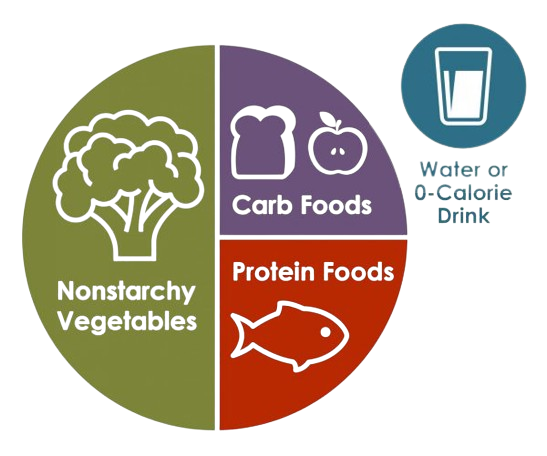Introducing the concept of a balanced diet – The Plate Method
Food provides the energy our bodies require to function. The energy in food is measured in units called calories. No food contains all of the nutrients our body needs and hence, eating a variety of foods in sufficient amounts is required. A healthy, nutritious diet consists of many different foods, preferably consumed throughout the day, and is sufficient in quantity and quality to meet individual’s need for energy (calories) and other nutrients. It should be highlighted that there is no ‘‘one-size fits all’’ diet and nutritional needs are specific to each person. Balance and variety in the diet equals ensuring that we get enough, but not too much, of the energy and nutrients we need.
The Plate Method offers a straightforward approach to healthy eating in today’s complex dietary landscape. By segmenting a standard plate into sections, half for non-starchy vegetables (e.g., carrots, tomatoes, spinach, lettuce etc.) a quarter for protein (e.g., meat, fish, eggs) and a quarter for foods high in carbohydrates (e.g., brown rice, pasta, potato), this method ensures a balanced intake without complex calculations.

While fats are not portioned on the plate, incorporating healthy fats like olive oil complements the emphasis on lean protein and low-fat vegetables. Critical factors for success include prioritising protein intake, avoiding processed foods, and aiming for plate balance. The visual guide of the Plate Method helps individuals achieve the correct proportions of each food group for a well-rounded diet, ensuring essential nutrient intake.
Embracing the Plate Method signifies a journey towards a well-balanced diet, focusing on increased protein, reduced processed foods, and the right proportions 9,10
Understanding macronutrients and their roles
The foods we eat provide us with nutrients – substances necessary for the growth, repair, and maintenance of body tissues (e.g., muscle, nerves etc.) and for the regulation of vital processes (e.g., breathing, blood circulation etc.). As the body cannot produce most of the nutrients, we must receive adequate amounts from the diet to meet our individual nutritional needs.
There are two types of nutrients: Macronutrients and Micronutrients.
Macronutrients are the nutrients that provide energy (calories) and are required in large amounts to maintain proper body functions and carry out the activities of daily life. Carbohydrates, proteins, and lipids are the three types of macronutrients.
By understanding what macronutrients do and where we can find them, we can make good choices about what to eat and stay healthy 11–13.
Explaining main food groups
Our food choices have a significant impact on our overall well-being and can help prevent serious illnesses such as heart disease, cancer, and diabetes. To maintain a healthy diet, it is important to consume a variety of food groups, including fruits, vegetables, legumes, whole grains, dairy, meats, fish, seafood, oils, fats, and drinks.
For individuals with gluten intolerance or celiac disease, gluten-free options are also available.
To ensure a balanced diet, aim for five servings of fruits and vegetables, 5-8 servings of whole grains, and 2-3 servings of dairy. It is crucial to consume the other food groups in moderation. Keep salt intake to a maximum of 5 grams daily and limit processed sugars to promote better health11,14.
Exploring micronutrients for energy and focus
Micronutrients work together with the macronutrients to provide energy, build and maintain tissues and to regulate all body’s processes. They are required to assist the body perform specific functions that promote growth, reproduction, and help maintain well-being, health and life overall. Micronutrients, i.e., vitamins, minerals, and trace elements, are needed in smaller quantities than macronutrients.
There are different types of vitamins and minerals that our body needs to stay healthy. Each vitamin and mineral has a specific function in the body and must be supplied in different, adequate amounts. Some vitamins dissolve in water and need to be taken regularly, while others dissolve in fat and can be stored in our bodies for more extended periods. Meanwhile, minerals are pivotal for overall health and are categorised as significant minerals and trace elements based on their recommended daily intake 9,14.
Highlighting the benefits of hydration and tips for staying hydrated at home
Here are some tips to stay hydrated at home 11:
- Drink plenty of water, and you can add some flavour to your water by putting fruit slices in it.
- Set a schedule for drinking water; use apps to track your water intake.
- Choose water-rich fruits and vegetables.
- Carry a water bottle with you.
- Limit alcohol, caffeine, and sugary drinks.
- Start and end your day with water.
References
[9]
Harvard T.H. Chan School of Public Health. Healthy Eating Plate | The Nutrition Source | . 2023. https://www.hsph.harvard.edu/nutritionsource/healthy-eating-plate/ (accessed 6 Nov2023).
[10]
ADA. Eating Well. 2023. https://diabetes.org/food-nutrition/eating-healthy (accessed 3 Nov2023).
[11]
WHO. Nutrition. 2022. https://www.who.int/health-topics/nutrition#tab=tab_1 (accessed 3 Nov2023).
[12]
BDA. Vegetarian, vegan and plant-based diet Food Fact Sheet. BDA 2021.
[13]
CDC. Food Labels | CDC. 2023. https://www.cdc.gov/diabetes/managing/eat-well/food-labels.html (accessed 3 Nov2023).
[14]
Alice Callahan P, Heather Leonard PR, Tamberly Powell MR. Nutrition: Science and Everyday Application. 2022.
















